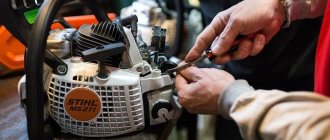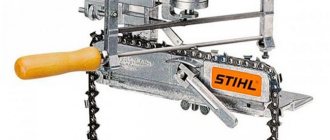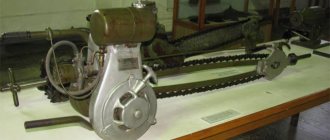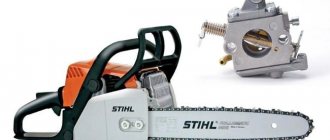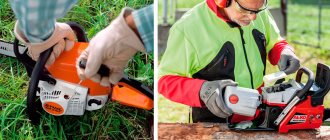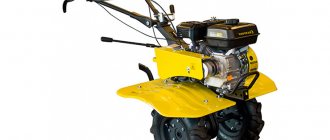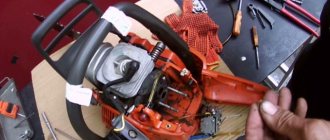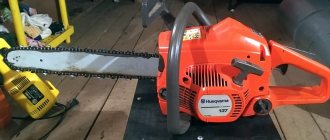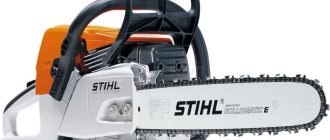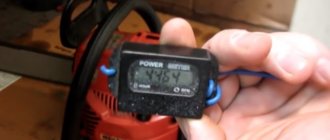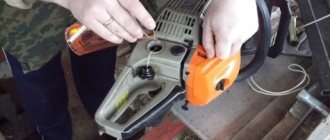Why does the chainsaw not develop speed?
There may be several reasons for the lack of traction and poor speed of the chainsaw. Therefore, you should not immediately start disassembling and repairing the carburetor, since the reason may not be hidden in it.
The Shtil MS 180 chainsaw is equipped with a reliable carburetor, on which the manufacturer has limited the ability to adjust the power and maximum engine speed, so if the chainsaw loses traction, the carburetor is the last place to look for problems.
Muffler
You may ask, which is the first? The answer is a muffler. The muffler is responsible for exhaust gases and extinguishing the flames in them. All combustion products pass through it, which can clog it over time. The situation with a muffler clogged with soot is far from uncommon, and it occurs due to an incorrect fuel mixture.
With a normal ratio of gasoline to oil, combustion products are not so saturated with soot that they clog the muffler. If the amount of oil is more than normal, excessive carbon deposits will form during its combustion. Further, carbon deposits accumulate under the piston rings and in the muffler of the Stihl 180 chainsaw. Thus, a coked muffler is the most harmless thing that can happen, the maximum damage from excessive carbon deposits is the need to replace the piston.
How to check the muffler
To check the muffler, it must be removed from the chainsaw. To do this, using an 8 mm socket, unscrew the two fastening nuts and remove the part.
Important: after the muffler is removed, it is necessary to check the integrity of the gaskets between it and the cylinder, since very often they stick and break when the muffler is removed.
You can clean the part mechanically, using screwdrivers or a knitting needle, and then blow it thoroughly with compressed air. The seat on the muffler can be cleaned with sandpaper to remove burnt parts of the gasket.
The muffler must be installed in the reverse order.
Important: when tightening the muffler mounting nuts, do not over-tighten the nuts, as the threads on the screws can be stripped.
The second reason why a calm chainsaw engine may reduce power and not develop speed is a blockage in the fuel system. As a rule, the first place to start looking for a blockage is the fuel filter.
Checking the fuel filter
The fuel filter is installed in the tank of the Shtil 180 chainsaw, and it is not very convenient to remove it. To make the process easier, you can take a small piece of aluminum wire and bend it at the end, then use it to hook the fuel hose and remove it, along with the filter, from the tank. To check the filter, you need to blow into it; if air does not pass through, then the cause has been found, and the filter needs to be replaced.
If the filter is clean, you need to check the fuel hose for clogging. To check, you need to disconnect it from the carburetor and, with the air filter removed, blow into it. If a blockage is detected, you can clean the hose mechanically, using a wire, and then blow it out with compressed air.
Strainer in carburetor
The last likely place for a blockage to form is the strainer in the carburetor. In the diagram below, it is indicated by the number 13.
In order to clean the mesh filter, you need to remove the carburetor from the Shtil 180 chainsaw. The work begins by removing the top cover of the saw, after which, using an 8 mm socket, unscrewing the two fastening nuts. Next, the filter housing is removed from the guides, after which the air damper rod and the engine control lever are disconnected. Lastly, the fuel hose and throttle linkage are disconnected, after which the carburetor can be removed from the guides.
The carburetor strainer is installed in the fuel pump chamber; in order to get to it, one screw securing the pump cover is unscrewed and it, along with the gaskets, is removed.
The mesh filter can only be cleaned using compressed air. Any mechanical methods are strictly prohibited, since the mesh is very soft and easily changes shape. When you press it, it easily wrinkles and bends form along the edge of the seat, through which unfiltered fuel can enter the carburetor.
During the cleaning process, the seat with the filter installed in it must be half covered with your finger and only then blow with air, otherwise the mesh may fly away and it will no longer be possible to find it.
Carburetor depressurization and nozzle blockage
Sometimes, when the screws securing the carburetor cover are loose or the gaskets have become unusable, the chainsaw may also experience a loss of power. To eliminate the possibility of this malfunction, it is necessary to check the integrity of the gaskets and the tightness of the screws on the carburetor covers. To do this, you need to remove it from the engine (the algorithm is described above) and disassemble it. Defective gaskets must be replaced using spare ones from the repair kit for the Shtil MS 180 carburetor.
In the case where a complete check of the fuel supply and exhaust gas system has been carried out, but there are no results. The main fuel injector valve needs to be checked. To check, you need to knock it out of the carburetor body. All work should proceed according to the following algorithm:
- The carburetor is removed from the chainsaw.
- The four screws securing the cover with the compensator are unscrewed, after which the cover can be removed.
- The carburetor is installed on a wooden lining, after which, using a bolt with a diameter of no more than eight millimeters and a length of 50, it is knocked out into the internal cavity of the carburetor.
- Next, you need to select a small hose, the inner diameter of which matches or is slightly smaller than the outer diameter of the nozzle and put it on the nozzle.
- The next step is to blow inside the hose. If it only blows in one direction, the nozzle is working properly; if it blows in both directions or does not blow at all, then the valve needs to be replaced.
All of the above actions should help in eliminating the problem associated with the fact that the chainsaw does not pick up speed, otherwise, a full diagnosis at the manufacturer’s service center will help.
How to check the muffler
To check the muffler, it must be removed from the chainsaw. To do this, use an 8 mm socket to unscrew the two fastening nuts and remove the part.
Read:
Fundamentally: after the muffler is removed, you need to check the integrity of the gaskets between it and the cylinder, since very often they stick and break when the muffler is removed.
You can clean the part mechanically, using screwdrivers or knitting needles, and then blow it well with compressed air. The seating area on the muffler can be cleaned with sandpaper to remove burnt parts of the gasket.
Why does the chainsaw not slow down?
There may be several reasons why a chainsaw does not slow down:
- throttle spring broken;
- jamming of the gas trigger;
- the throttle linkage is bent;
- The corkscrew of the throttle shaft is lost, causing it to jam.
It is not difficult to solve all these problems; you need to conduct a careful inspection and accurately determine the cause, and then replace the faulty part. As a rule, if the chainsaw picks up speed well, idles and has normal power, then the problem with the fact that it does not slow down is purely mechanical. And finding and eliminating a mechanical fault is much easier than identifying and stopping air leaks in the chainsaw crankcase.
Troubleshooting Methods
The first three reasons are quite easy to eliminate. If it is a mixture, you will need to empty the old fuel from the tank, make a new emulsion of quality gasoline and motor oil (if your engine requires a mixture), and pour it into the fuel tank. If the trimmer runs on pure gas, this is still easier.
In the second case, the trimmer parts should be carefully freed from the wound grass. The final reason why the queen square is not working properly will require a little more knowledge and skill on your part.
The final reason why the queen square is not working properly will require a little more knowledge and skill on your part.
Follow the procedure to properly adjust the carburetor brush. First, clean the air filter thoroughly. It is the easiest to clean (it is advisable to regularly rinse the filter with water after 9-10 hours).
Next, locate the adjustment screws on your trimmer's diagram, which is located in the device's instruction manual. Usually there are three of them: the first is responsible for supplying fuel, the second. At idle, and the third is designed to limit the number of maximum engine speeds.
Then turn on the device and wait until the engine warms up.
Slowly tighten the first adjustment screw (fuel mixture supply). Catch the moment when the engine starts to stop and turn the propeller in the opposite direction 45 degrees. If you don't have time and the engine stops, turn the propeller 90 degrees. Open the throttle and watch the speed increase. Then slowly unscrew the screw (45 degrees each turn) until the engine reaches maximum speed at full throttle.
The second screw, as mentioned above, regulates the idle speed of the engine. By loosening it, you reduce the number of revolutions and rotate. Increase it. The propeller must be adjusted to ensure reliable engine operation at low speeds. For better starting, increase engine speed slightly. At the same time, make sure that the motor makes several dozen revolutions before moving the knives/spools of line. If the engine does not start properly, tighten the screw slightly.
After you have adjusted the first two screws, check the operation of the device at maximum engine speed. If necessary, you can limit it (maximum). This will protect the engine from boiling. To do this, you need to engage the third screw. Loosen the locknut until the adjusting screw is turned quietly. To increase the maximum number of revolutions, the screw must be unscrewed and reduced. On the contrary, tighten it. Lock the screw position nut. Check the engine again.
Remember that regulating carbohydrates is not a permanent procedure. You'll likely have to work with the brush more than once while the brush is running, as an unbalanced carburetor means both increased fuel consumption and faster spark plug failure, not to mention reduced power and efficiency of the unit.
Conclusion
If the first signs of loss of power (reduction in speed) appear with the Shtil MS 180 chainsaw, under no circumstances should you continue to work, but you should immediately contact a specialist or carry out diagnostics and fix the malfunction yourself. There are not many reasons for power loss and you can cope with them even without certain skills. The main thing is to calmly analyze the behavior of the saw and find out the reasons why it stopped pulling (the speed dropped), and eliminating the malfunction is not a difficult task.
Home page » Chainsaw Shtil 180 Doesn’t Develop Speed
Related Posts
Why does the chainsaw stall when I press the gas: premises and solution
There are often cases when owners of chainsaws are faced with their breakdown and it does not matter at all what model of this type of equipment, because the nature of breakdowns is almost the same for everyone. Well, the chainsaw has stalled, so what next? Of course, you can take the equipment to special services that will repair your “iron friend” for a fee. Chainsaw Shtil 180 does not supply oil and supply oil to the chain?. But as they say: why pay more?
After all, you can personally disassemble the tool and repair it, because the damage may be insignificant, but in the service you will pay a lot for it. But naturally, in order to bring a tool back to life yourself, you need to be able to understand the reasons for its breakdown and methods for eliminating defects. On chainsaws Shtil ms 180 rpm cannot be adjusted. So let's educate ourselves! In this article you can find answers to questions regarding situations when the tool simply stalls after a specific press on the gas. So let's get started.
Basic elements of chainsaws
Before we begin to delve into the issues of tool breakdowns and repairs, let’s first understand what a chainsaw actually consists of. First, I would like to note that this tool belongs to the category of equipment whose operation directly depends on the gasoline engine.
It is also important that chainsaws are equipped with an engine with one cylinder , and the work of which is done on such fuel as gasoline. It should be noted that, despite the similarity with other tools, it does not have a gearbox. And it is replaced by a typical single-stage chain transmission, the means of which is the movement of the chain (saw) itself.
The saw does not develop speed, does not develop power.
Why doesn't Stihl 180
starts,
does not develop speed
, Friends, if something needs to be explained in more detail, ask.
And also use only the oil that is made by the manufacturer of your tool. Chainsaw calm 180 - does not develop speed. Chainsaw Calm 180 - does not develop Chainsaw Calm 180 does not develop speed, stalls. In addition, it is important to prepare this kind of mixture in the amount that you will definitely use in one or two weeks, but no more (see the proportion of gasoline and chainsaw oil).
Because otherwise, overexposure of the mixture directly in the canister will lead to it losing all its octane properties and this will lead to significant problems with the instrument.
Application
In practice, this is a tool whose basic meaning is quite difficult to clearly define. The fact is that such equipment is universal and has a very wide scope of application. For example, it is very relevant when performing gardening, construction, and other types of work.
Many summer residents and gardeners purchase lightweight models for caring for fruit trees in their country plots. That is, these days, a chainsaw has undoubtedly become a high-performance alternative to a handsaw or an ax. And almost every craftsman is familiar with the features of its operation and adjustment of the spark plug gap.
But do all owners of summer cottages know how to repair such equipment in case of any malfunctions in its operation? Let's discuss further what to do if your chainsaw won't start and the spark plug is flooding. We’ll also talk about why this happens.
Additional Tips
First of all, what you should remember when purchasing this kind of tool is that certain parts of the saw need to be replaced with new ones after their service life (passport) has expired. It is for this reason that the instructions should always be at your fingertips, since everything is described there in detail.
These types of parts include: a sprocket (drive), a tire, part of the system (anti-vibration), as well as a chain . Since we should not forget that if this “filling” is not replaced with a new one at the required time, then these worn-out spare parts will negatively affect the remaining parts of the chainsaw. It is for this reason that you should check the depth of the immediate tooth cutting quite often. Remember that it should not be higher than 0.5 mm a week.
Malfunctions of the cutting set
A sufficiently lubricated and sharpened chain at the correct angle is one of the main advantages in the operation of Shtil petrol saws. During operation, the chain may jam, often due to clogged lubricant supply pipes or a breakdown of the fuel pump. When a chain becomes jammed, it often breaks, creating a risk of injury to the user. A circuit break can occur for other reasons:
- the lubricating fluid has run out or is not supplied in sufficient quantities;
- the driving or driven sprockets are worn out;
- foreign objects getting into the chain links;
- poor quality of the metal of the chain, or overheating of its teeth;
- operation of an unsuitable saw blade (chain).
It is very important to accurately maintain the sharpening angle of the chain. Not only does the cutting speed depend on this, but also its accuracy.
The Stihl company produces a whole range of specialized sharpening machines for sharpening various types of chains in an automated mode.
To sum it up...
Definitely, every item we buy has its own expiration date and sooner or later it breaks, and it becomes a shame when the degree of its breakdown is so great that it cannot be repaired. But you must admit that quite often we simply treat technology negligently, and when it stops working, then we try to find ways to fix the breakdown, turning to a huge number of services.
But remember that even though the equipment breaks down, we can extend its “life” . All you need to do is simply take care of it and keep its parts clean and tidy. And then, undoubtedly, it will serve for many more years. It is also important to use exclusively high-quality spare parts and “additives” (see attachments for chainsaws). Then your equipment will work smoothly, and you will simply forget what repairs are.
For what reasons does Shtil 180 stall at idle or full throttle?
Why does a chainsaw stall when you press the gas?
idling normally.
, but when you press the gas hard it stalls. What could be the reason? It is immediately clear that the issue is not the ignition (lack of spark), because if the ignition was faulty and there was no spark, the tool simply would not start. This means the fuel system remains.
There are a lot of malfunctions in the fuel system, and to determine the exact reason why the Stihl 180 chainsaw stalls when you press the gas, it is necessary to carry out a complete diagnosis of it. We recommend reading about common malfunctions of the Shtil 180 chainsaw and their elimination.
Refusal to work
The Shtil 180 chainsaw, the faults of which you can identify and repair yourself, sometimes simply does not start. This problem can arise completely by accident. First of all, the consumer needs to open and close the gas tank cap again. Ventilation of the combustion chamber must be carried out in the next step.
It is recommended to remove the candles and dry them well. In some cases, this is enough for the tool to start and work properly. If the problem remains, then the reason is different. The breather affects the fuel supply. If it becomes clogged, a vacuum occurs in the fuel tank, which results in failure of operation. The breather can be repaired very simply. To do this, it is cleaned with a needle.
If you purchased a Shtil 180 chainsaw, you can find and repair this tool yourself. Sometimes equipment fails to work because the cylinder fails. If there are unevenness and chips on this unit, then this is definitely the reason. If you encounter a problem where the tool does not start, holds power for a short time, or stalls after turning on, then the muffler may be causing the problem. During operation, it sometimes becomes clogged with deposits that occur during exhaust.
The saw sometimes has difficulty starting, which is caused by starter malfunctions. In order to identify the problem, it is necessary to remove the cover and a special screen from the carburetor, which is located behind the tool drum. If the contact wire is disconnected from the starter, it is fixed with a blowtorch. Sometimes the problem is an oil leak. In this case, the starter must be wiped with a rag.
Filter check
The first thing you need to check is the fuel filter.
In some cases, a filter clogged with dirt is unable to pass through the fuel mixture in sufficient quantities. Accordingly, there is a shortage of fuel in the system, which leads to the fact that when you press the gas of the chainsaw, the fuel burns out, and new fuel does not yet have time to arrive, as a result of which the Shtil chainsaw stalls. Also, if the fuel filter is clogged, there may be a noticeable drop in the power of the chainsaw at maximum speed, but this is with minor contamination.
Chainsaw Shtil 180 stalls at idle.
Description of the device and technical parameters
Shtil 180 has a standard configuration. However, like all modern chainsaws. Its components:
- Front and rear handle with anti-vibration system.
- Saw bar with chain.
- Two-stroke single-cylinder engine.
- Fuel and ignition systems.
- Housing made of high quality plastic.
Chainsaw Shtil 180, technical characteristics:
- A gasoline engine that runs on a mixture of fuel and oil in a ratio of 1:50. It has a power of 2 liters. With.
- The weight of the saw is approximately 4 kg.
- The saw is equipped with an easy start system.
- The capacity of the fuel and oil tanks is 250 and 140 ml, respectively.
- The saw bar is 14 inches (35 cm) long.
- Automatic chain lubrication.
Air filter
On the pages of the World Wide Web, you can find information that the Shtil 180 chainsaw may stall due to severe contamination of the air filter . I would like to refute this not entirely correct information and report that the Shtil MC 180 carburetor is equipped with a compensator, which is designed and installed in order to take in the air necessary for the normal operation of the Shtil 180 chainsaw, bypassing the dirty air filter. Of course, the power with a clogged air filter will drop slightly, but it definitely won’t stall. The power may also drop due to piston wear, which will require repair of the Stihl MS 180 piston chainsaw.
Related Posts
Carburetor
One of the reasons why a chainsaw does not develop speed when you press the gas, but rather stalls, is a malfunction of the carburetor. Let’s say the Shtil 180 saw worked properly, and then it was installed for a long time and was not used. Afterwards it was started, and at idle it works well, but when you press the gas it can stall. Why does it stall? The reason is a stuck carburetor valve nozzle. Of course, this is not 100%, but the probability of such a malfunction is high. We recommend reading the article about the design and repair of the Shtil 180 carburetor.
In order to check the nozzle, you need to remove the carburetor and disassemble it. To remove, you need to unscrew the two nuts securing the air filter and the carburetor, then remove the air filter and the engine control lever, while disconnecting the air damper control rod from the carburetor. Next, you need to slightly pull the carburetor towards you and disconnect the fuel supply hose.
Chainsaw Shtil 180 stalls at idle.
You need to remove the fuel hose as carefully as possible and prepare a plug for it in advance, since fuel should come out of it.
After removing the carburetor, you need to blow it out and clean it of dirt, only after that the carburetor can be untwisted.
It is necessary to unscrew the cover of the main chamber of the carburetor; this is the one on which the compensator is installed on top. Next, use an 8 mm bolt and a length of at least 50 mm. We knock out the valve.
Troubleshooting Methods
The first three reasons are quite easy to eliminate. If the problem is the mixture, you need to pour the old fuel out of the tank, prepare a new emulsion from high-quality gasoline and motor oil (if your engine requires a mixture) and pour it into the fuel tank. If the trimmer runs on pure gasoline, everything is even easier.
In the second case, it is necessary to carefully free the trimmer parts from the wound grass. If the filter is clogged, you can try washing it
If this procedure does not bring any effect, replace it with a new one.
If the filter is clogged, you can try washing it. If this procedure does not bring any effect, replace it with a new one.
The last reason why your lawn mower is not working properly will require a little more knowledge and skill on your part.
To properly adjust the carburetor of a lawn mower, you must follow a certain procedure. First of all, thoroughly clean the air filter. The easiest way is to wash it (it is advisable to spray the filter with water regularly after 9–10 hours of use).
After this, in the diagram of your trimmer, which is in the operating instructions for the device, find the adjustment screws. Usually there are three of them: the first is responsible for fuel supply, the second is for idling, and the third is designed to limit the number of maximum engine speeds.
Next, turn on the unit and wait for the engine to warm up.
Slowly tighten the first adjustment screw (fuel mixture supply). Catch the moment when the engine begins to stall and turn the screw in the opposite direction by 45 degrees. If you don’t have time and the engine stalls, the screw should be turned 90 degrees. Open the throttle and watch the revs increase. Next, you should slowly unscrew the screw (each turn is the same 45 degrees) until the moment when, at full throttle, the engine begins to firmly produce maximum revolutions.
The second screw, as mentioned above, controls the engine speed at idle. By loosening it, you reduce the number of revolutions, and by tightening it, you increase it. The screw must be adjusted so as to ensure reliable operation of the motor at low speeds. For better starting, speed up the engine a little. At the same time, make sure that the motor makes several dozen revolutions before the knives/reel with fishing line starts moving. If the engine starts poorly, tighten the screw a little.
After you have adjusted the first two screws, test the operation of the device at maximum engine speed. If necessary, you can limit it (maximum) - this will protect the motor from “boiling.” To do this you need to take care of the third screw. Unscrew the fixing nut until the adjusting screw can be easily turned. To increase the maximum number of revolutions, you need to loosen the screw; to decrease it, on the contrary, tighten it. Secure the position of the screw with a nut. Test the operation of the motor again.
Check the position of the screws regularly - the high level of vibration inherent in lawn mowers can cause them to move unintentionally.
Remember that carburetor adjustment is not a final procedure. During the operation of the lawn mower, you will most likely have to tinker with it more than once, because an unbalanced carburetor means increased fuel consumption and rapid failure of spark plugs, not to mention a decrease in the power and performance of the device.
Spark plug problems
When the gas trimmer is used frequently, you need to monitor the condition of the spark plugs. This part is subject to wear, so they need to be inspected regularly to see if there is carbon deposits on them.
There are two ways to solve the problem: clean the old candle from burning or buy a new one.
In the first case, you need to unscrew it, sand it with sandpaper, and dry it. The distance between the electrodes should be 1 mm. The trimmer is assembled and started.
If there is no spark between the electrodes, it is worth inspecting the quality of the connections of all circuit elements. If in this case everything is fine, then you 100% need to change the spark plugs.
Replacing them is easy and inexpensive. The tools you will need are a key and a needle file.
Important! If carbon deposits often appear on combustion plugs, it is worth looking a little deeper for the cause. Candles should be thoroughly cleaned of deposits.
Candles should be thoroughly cleaned of deposits.
Chainsaw Stihl MS 180 problems with speed
Chainsaw Stihl
MS
180
has some nuances that make owners nervous and is expensive.
It is necessary to knock out the valve by placing the carburetor on a wooden stand, this will protect it from damage to the body.
After the nozzle is removed, you can blow it out using a compressor. The valve should only allow air to flow in one direction; if the valve can be freely blown in both directions, it means it is faulty and needs to be replaced with a new one. Reassembling the chainsaw after the valve has been repaired must be carried out in the reverse order of disassembly.
You can see clearly how a carburetor is repaired, or rather, how to correctly knock out the injector valve from the carburetor body by watching the video.
Another common reason why a saw may stall when the speed increases is air leaking into the carburetor. This can only be checked with a special tool, but it is worth noting that if preventive work has not been carried out on the carburetor for a long time, then you can install a new set of gaskets in the carburetor. In some cases, this helps solve the problem of its depressurization.
Chainsaw Shtil 180 does not develop speed for the reason.
When disassembling the carburetor to replace the gaskets, you need to carefully inspect its needle valve, press the rocker arm and check its lifting. Sometimes, especially after the Stihl chainsaw has stood for a long time with fuel in the carburetor, the needle may burn to the carburetor body and not perform its functions. Simply put, the needle valve will not allow the fuel mixture to pass through. In this case, the saw will not work.
Why does it stall at idle?
Related Posts
The first and most common cause of this malfunction is incorrect carburetor adjustment. You can adjust the idle speed yourself; for this you need to have a Stihl adjusting screwdriver, which is supplied with the unit. The adjustment hole is located on the right side of the Shtil 180 saw on the handle and is indicated by the symbols “-” and “”.
If the Shtil does not hold speed and stalls at idle
, you can be almost 90% sure that there is a problem with the fuel pump; as a rule, this is air leaking into the crankcase through the pan gasket, or, more often, through the crankshaft seals. Air leakage reduces or completely stops the impulse, which is supplied through special channels to the fuel pump of the chainsaw. As a result of this, the Stihl 180 chainsaw does not receive the required amount of fuel and stalls at idle.
Diagnostics can be carried out using a special device called a vacuum gauge.
The Stihl 180 chainsaw does not pick up speed and stalls.
The second way to check the performance of the oil seals is to pour gasoline into the engine crankcase and look at them; if the oil seals leak gasoline, it means they cannot provide normal pressure in the crankcase, which will make idling impossible. And when operating at high speeds, with leaky oil seals, there is a possibility of the crankshaft bearings jamming.
The algorithm for checking the Shtil 180 crankcase and seals for leaks is as follows:
- The top cover is removed.
- The air filter housing and carburetor are dismantled.
- The chainsaw handle is removed.
- The starter spins up and retracts.
- On the side opposite the starter, the side cover and drive sprocket are removed.
- A piston stopper is installed in the spark plug hole or a string from an old starter with knots tied on it is stuffed into the cylinder.
- The flywheel and clutch are unscrewed, after which the parts are removed. It is worth knowing that the chainsaw clutch has a left-hand thread and unscrews clockwise.
- The oil pump drive gear is removed.
Having disassembled the Stihl MS 180 chainsaw, you can see the oil seals, after which you need to fill the crankcase with gasoline and check for leaks. The crankcase can be filled through the fuel window in the cylinder; to do this, the piston must be raised as high as possible. If leaks are detected, it is necessary to replace defective oil seals or re-seal the pan. You can assemble Shtil 180 by following the reverse sequence of the algorithm.
Calm 180 does not pick up speed and stalls.
What surfaces is Alpina suitable for?
Alpina facade paints can be used on almost any substrate:
- Concrete.
- Facing and ordinary bricks (clay, silicate, etc.).
- All types of plaster (cement, lime, textured mixtures).
- Old dispersion coating.
- Dispersion putties.
It is recommended to keep freshly applied lime-cement plasters for 4 weeks to remove carbon dioxide from them and complete chemical reactions.
Surfaces with high absorbency (porous or cellular materials, aerated concrete, etc.) should be pre-primed with appropriate primers with antiseptic properties.
When using plasterboard boards, you can do without preliminary priming.
Why does it stall at full speed?
Very often you can hear the question why a chainsaw stalls at full speed. There may be several reasons. First, you need to consider exactly how the saw stalled. Let's say the tool was working normally and suddenly, for no apparent reason, it suddenly stalled and the starter does not turn over. In such a situation, you can be 100% sure that the chainsaw is jammed and you need to start overhauling it.
The second situation is when the Shtil 180 chainsaw worked normally, then gradually lost power in a short time and stalled, and the cylinder overheated. In this case, the most likely reason is air leakage under the rubber pipe connecting the carburetor to the cylinder or its rupture. The mixture became lean, resulting in overheating. The cause can be eliminated by changing the pipe.
